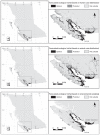Ecological niche modeling of Cryptococcus gattii in British Columbia, Canada
- PMID: 20439176
- PMCID: PMC2866681
- DOI: 10.1289/ehp.0901448
Ecological niche modeling of Cryptococcus gattii in British Columbia, Canada
Abstract
Background: Cryptococcus gattii emerged on Vancouver Island, British Columbia (BC), Canada, in 1999, causing human and animal illness. Environmental sampling for C.gattii in southwestern BC has isolated the fungal organism from native vegetation, soil, air, and water.
Objectives: Our aim was to help public health officials in BC delineate where C.gattii is currently established and forecast areas that could support C.gattii in the future. We also examined the utility of ecological niche modeling (ENM) based on human and animal C.gattii disease surveillance data.
Methods: We performed ENM using the Genetic Algorithm for Rule-set Prediction (GARP) to predict the optimal and potential ecological niche areas of C.gattii in BC. Human and animal surveillance and environmental sampling data were used to build and test the models based on 15 predictor environmental data layers.
Results: ENM provided very accurate predictions (> 98% accuracy, p-value < 0.001) for C.gattii in BC. The models identified optimal C.gattii ecological niche areas along the central and south eastern coast of Vancouver Island and within the Vancouver Lower Mainland. Elevation, biogeoclimatic zone, and January temperature were good predictors for identifying the ecological niche of C.gattii in BC.
Conclusions: The use of human and animal case data for ENM proved useful and effective in identifying the ecological niche of C.gattii in BC. These results are shared with public health to increase public and physician awareness of cryptococcal disease in regions at risk of environmental colonization of C.gattii.
Figures



Similar articles
-
Searching for clues for eighteen years: Deciphering the ecological determinants of Cryptococcus gattii on Vancouver Island, British Columbia.Med Mycol. 2018 Feb 1;56(2):129-144. doi: 10.1093/mmy/myx037. Med Mycol. 2018. PMID: 28525610 Review.
-
Characterization of environmental sources of the human and animal pathogen Cryptococcus gattii in British Columbia, Canada, and the Pacific Northwest of the United States.Appl Environ Microbiol. 2007 Mar;73(5):1433-43. doi: 10.1128/AEM.01330-06. Epub 2006 Dec 28. Appl Environ Microbiol. 2007. PMID: 17194837 Free PMC article.
-
A decade of experience: Cryptococcus gattii in British Columbia.Mycopathologia. 2012 Jun;173(5-6):311-9. doi: 10.1007/s11046-011-9475-x. Epub 2011 Sep 30. Mycopathologia. 2012. PMID: 21960040
-
Surveillance for Cryptococcus gattii in horses of Vancouver Island, British Columbia, Canada.Med Mycol. 2011 Oct;49(7):734-8. doi: 10.3109/13693786.2011.560196. Epub 2011 Mar 7. Med Mycol. 2011. PMID: 21375433
-
Spread of Cryptococcus gattii into Pacific Northwest region of the United States.Emerg Infect Dis. 2009 Aug;15(8):1185-91. doi: 10.3201/eid1508.081384. Emerg Infect Dis. 2009. PMID: 19757550 Free PMC article. Review.
Cited by
-
Cryptococcus gattii: a resurgent fungal pathogen.Trends Microbiol. 2011 Nov;19(11):564-71. doi: 10.1016/j.tim.2011.07.010. Epub 2011 Aug 29. Trends Microbiol. 2011. PMID: 21880492 Free PMC article. Review.
-
Global transcriptome profile of Cryptococcus neoformans during exposure to hydrogen peroxide induced oxidative stress.PLoS One. 2013;8(1):e55110. doi: 10.1371/journal.pone.0055110. Epub 2013 Jan 28. PLoS One. 2013. PMID: 23383070 Free PMC article.
-
Genome variation in Cryptococcus gattii, an emerging pathogen of immunocompetent hosts.mBio. 2011 Feb 8;2(1):e00342-10. doi: 10.1128/mBio.00342-10. Print 2011. mBio. 2011. PMID: 21304167 Free PMC article.
-
The Fungus among Us: Cryptococcus neoformans and Cryptococcus gattii Ecological Modeling for Colombia.J Fungi (Basel). 2015 Sep 30;1(3):332-344. doi: 10.3390/jof1030332. J Fungi (Basel). 2015. PMID: 29376914 Free PMC article.
-
Cryptococcus gattii VGII isolated from native forest and river in Northern Brazil.Braz J Microbiol. 2019 Apr;50(2):495-500. doi: 10.1007/s42770-019-00066-6. Epub 2019 Mar 9. Braz J Microbiol. 2019. PMID: 30852797 Free PMC article.
References
-
- Agriculture and Agri-Food Canada. SLCS 2.2. 1995. [accessed 27 March 2006]. Available: http://sis.agr.gc.ca/cansis/nsdb/slc/v2.2/intro.html.
-
- Bartlett KH, Kidd SE, Kronstad JW. The emergence of Cryptococcus gattii in British Columbia and the Pacific Northwest. Curr Fungal Infect Rep. 2007;10(1):108–115. - PubMed
-
- BC (British Columbia) Ministry of Forests and Range, Research Branch. Biogeoclimatic Ecosystem Classification, Version 6.0. 2006. [accessed 27 March 2006]. Available: http://www.for.gov.bc.ca/hre/becweb/resources/maps/gis_products.html.
-
- Casadevall A, Perfect JR. Cryptococcus neoformans. Washington, DC: American Society for Microbiology; 1998. Ecology of Cryptococcus neoformans; pp. 41–70.
Publication types
MeSH terms
LinkOut - more resources
Full Text Sources

